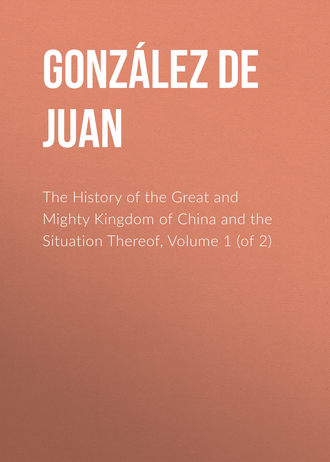 полная версия
полная версияThe History of the Great and Mighty Kingdom of China and the Situation Thereof, Volume 1 (of 2)
102
More properly Ngan-tcha-see.
103
More properly Hai-tao. Respecting these offices see Du Halde, vol. ii, fol. 32, 33.
104
Standard-bearer.
105
More properly Paou-yin.
106
This and the preceding title seem to be the same as those similarly spelt on page 103.
107
Perhaps the Koo-ta-sze, or treasurer.
108
Perhaps the Che-tsze, or secretary.
109
Taou, tae, the intendant of circuits.
110
More properly Kwan-paou, commissioner of customs. See Morrison's View of China, p. 94.
111
Perhaps Te-paou, a police runner.
112
More properly Yuen-chae, a police constable.
113
Perhaps Ching-tang, assistant officer in a prise.
114
Shin is the Chinese for the verb "to judge", and with the word officer added to it will be "a judging officer". Thus also leu-law, prefixed to che-to rule, or govern, may be the origin of the term Leuchi. This construction is, however, entirely conjectural.
115
See note on page 113.
116
This character is so vague as to be scarcely recognizable. The proper Chinese word for heaven is tien. The word here given may perhaps mean tsang, the azure sky, which is sometimes used metaphorically for heaven. At the same time the modern Chinese character for Keen, also pronounced Kan

117
Evidently hwang te, the character here given corresponding with the modern Chinese character Hwang.

118
This character would seem to be intended for ching, – a walled city, the correct form of the character being

119
Fucheou, the capital of Fokien.
120
Padrinos, Span. – Literally sponsors.
121
A German.
122
A misprint for Pegu.
123
Mis-translated from the Spanish "Tudesco", a German. The reader will readily recognize the name of Johann Gutemberg or Ganzfleisch, of Mentz, who disputes with Laurens Koster, of Haarlem, the honour of having invented and first practised the art of printing with moveable types.
124
Conrad Sweynheim, who, in partnership with Arnold Pannartz, published in 1465, at the Monastery of Subiaco, near Rome, the Lactantii Opera, 4to., the first work printed in Italy. The De Civitate Dei of St. Augustine, was printed by the same printers at Subiaco two years later. It is now known that the first book printed in Europe with metal types, was the Mazarine Bible, printed by Gutemberg and Fust, at Mentz, in 1455.
125
Germany.
126
Printing without moveable types does not go back, even in China, beyond the beginning of the tenth century of our era. The first four books of Confucius were printed, according to Klaproth, in the province of Sze-chuen, between 890 and 925, and the description of the technical manipulation of the Chinese printing press might have been read in western countries even as early as 1310, in Raschid Eddin's Persian history of the rulers of Khatai. According to the most recent results of the important researches of Stanislas Julien, however, an ironsmith in China itself, between the years 1041 and 1048, a. d., or almost 400 years before Gutemberg, would seem to have used moveable types made of burnt clay. This is the invention of Pi-sching, but it was not brought into application. See Humboldt's Kosmos, translated by Otté, fol. 623. Moveable types are now no longer used, for as Sir John Davis observes, vol. ii, p. 222, "the present mode of Chinese printing with wooden stereotype blocks is peculiarly suited to the Chinese character, and for all purposes of cheapness and expedition is perfect". A complete set of the materials used by the Chinese in the process of printing, may be seen in the Museum of the Royal Asiatic Society. In the note on page 121 of Hakluyt's Divers Voyages, edited for the Hakluyt Society by J. Winter Jones, Esq., the following description is given of a book printed in 1348: "The earliest work of which we have been able to obtain an account, from one having had the opportunity of personally inspecting it, bears date the eighth year of the last period of the reign of Shun Te, or a. d. 1348. Mr. Prevost, our informant, who is at present engaged in cataloguing the splendid collection of Chinese books in the British Museum, has favoured us with the following description of the book. The title is 'Chin Tsaou Tsëen Wan, or the Thousand Character Classic'. It is one of the most popular works in China, and consists of exactly one thousand different characters, not one being repeated. It is composed in octosyllabic verses, which rhyme in couplets; each verse presenting to the student some useful Chinese notion, either in morals or in general knowledge. The object of this work is to teach the written character, both in its semi-cursive and in its stenographic form, termed Tsaou, or grass-writing: the text is, therefore, printed in parallel columns, alternately in the Chin, or correct, and the Tsaou, or cursive character. The author lived in the first half of the sixth century. This work, when seen by Mr. Prevost, was in the possession of Colonel Tynte." The Editor has also in his own possession a Chinese bank note, printed, or rather stamped, in the fourteenth century.
127
Hou-quang.
128
A sort of confection made of almonds, sugar, etc.
129
Bever, probably from bevere, Ital., to drink, a small collation between dinner and supper.
130
Vname, is probably Yew ma, – pitch, or the resin of the pine. In Morrison's Dictionary, "tar" is translated Pa ma yew: but the Editor finds nothing analogous to Ja pez, which is probably now obsolete.
131
The Goletta of Tunis was taken from the Spaniards by Sinan Pacha, admiral of Selim II, on the 23rd of August 1574.
132
Mistranslated for "the extensive knowledge which I had of navigation."
133
Misspelt for Corunna.

